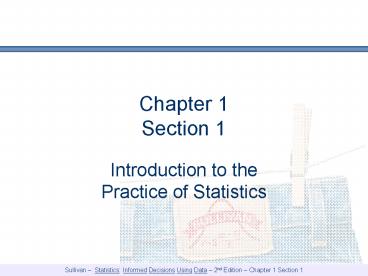Chapter 1 Section 1 - PowerPoint PPT Presentation
1 / 13
Title:
Chapter 1 Section 1
Description:
Sullivan Statistics: Informed Decisions Using Data 2nd Edition ... Understand the difference between direct and indirect (lurking variable) relations ... – PowerPoint PPT presentation
Number of Views:150
Avg rating:3.0/5.0
Title: Chapter 1 Section 1
1
Chapter 1Section 1
- Introduction to the
- Practice of Statistics
2
Chapter 1 Section 1
- The science of statistics is
- Collecting
- Organizing
- Summarizing
- Analyzing
- information to draw conclusions or answer
questions
3
Chapter 1 Section 1
- Anecdotal claims, as opposed to statistics, are
- Conclusions based on very little data
- Stories and rumors
- Anecdotal claims, as opposed to statistics, are
- Conclusions based on very little data
- Stories and rumors
- Data can be misused when
- Data is incorrectly obtained
- Data is incorrectly analyzed
- Anecdotal claims, as opposed to statistics, are
- Conclusions based on very little data
- Stories and rumors
- Data can be misused when
- Data is incorrectly obtained
- Data is incorrectly analyzed
- Good statistics should
- Understand the difference between direct and
indirect (lurking variable) relations - Understand the impacts of variability
4
Chapter 1 Section 1
- Statisticians Creed In God We Trust.all
others, bring data! - G.I.G.O. Garbage In, Garbage Out!
- Our text talks about design of a data collection
method early to emphasize the importance!
5
Chapter 1 Section 1
- A population
- Is the group to be studied
- Includes all of the individuals in the group
- A population
- Is the group to be studied
- Includes all of the individuals in the group
- A sample
- Is a subset of the population
- Is often used in analyses because getting access
to the entire population is impractical
6
Chapter 1 Section 1
- Organize and summarize the information
- Descriptive statistics (chapters 2 through 4)
- Visual methods such as charts and graphs
- Numeric methods such as calculations
- Organize and summarize the information
- Descriptive statistics (chapters 2 through 4)
- Visual methods such as charts and graphs
- Numeric methods such as calculations
- Draw conclusions from the information
- Inferential statistics (chapters 8 through 15)
- Various methods that are appropriate for
different questions and different types of data
sets
7
Chapter 1 Section 1
- Characteristics of the individuals under study
are called variables - Some variables have values that are attributes or
characteristics those are called qualitative or
categorical variables - Some variables have values that are numeric
measurements those are called quantitative
variables - The suggested approaches to analyzing problems
vary by the type of variable
8
Chapter 1 Section 1
- Examples of qualitative variables
- Gender
- Zip code
- Blood type
- States in the United States
- Brands of televisions
- Qualitative variables have category values
those values cannot be added, subtracted, etc.
9
Chapter 1 Section 1
- Examples of quantitative variables
- Temperature
- Height and weight
- Sales of a product
- Number of children in a family
- Points achieved playing a video game
- Quantitative variables have numeric values
those values can be added, subtracted, etc.
10
Chapter 1 Section 1
- Quantitative variables can be either discrete or
continuous
- Quantitative variables can be either discrete or
continuous - Discrete variables
- Variables that have a finite or a countable
number of possibilities - Frequently variables that are counts
- Quantitative variables can be either discrete or
continuous - Discrete variables
- Variables that have a finite or a countable
number of possibilities - Frequently variables that are counts
- Continuous variables
- Variables that have an infinite but not countable
number of possibilities usually ranging over
interval - Frequently variables that are physical
measurements
11
Chapter 1 Section 1
- Examples of discrete variables
- The number of heads obtained in 5 coin flips
- The number of cars arriving at a McDonalds
between 1200 and 100 - The number of students in class
- The number of points scored in a football game
- How many typos there are in this presentation
12
Chapter 1 Section 1
- Examples of continuous variables
- The distance that a particular model car can
drive on a full tank of gas - Heights of college students
- Density of a liquid
- Mass of a textbook
13
Summary Chapter 1 Section 1
- The process of statistics is designed to collect
and analyze data to reach conclusions - Variables can be classified by their type of data
- Qualitative or categorical variables
- Discrete quantitative variables
- Continuous quantitative variables






























